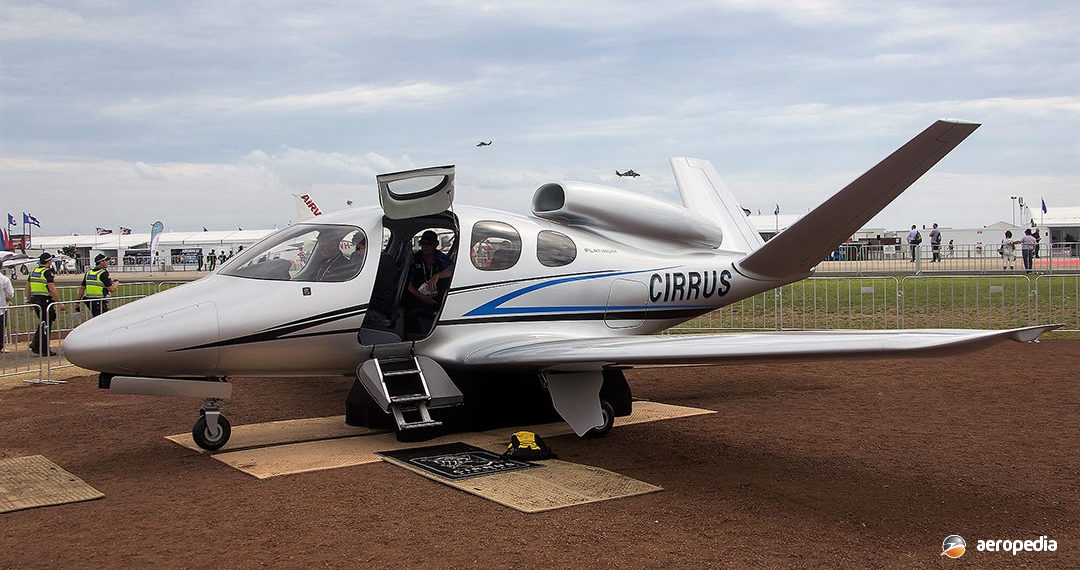Photograph:
Mock-up of the Cirrus Vision Jet shown at the Australian International Air Show at Avalon, VIC in 2015 (David C Eyre)
Country of origin:
United States of America
Description:
Single-engine light private jet
Power Plant:
One 1,800 lbst Williams FJ33-4A-19 turbofan
Specifications:
- Wingspan: 11.79 m (38 ft 8 in)
- Length: 9.42 m (30 ft 11 in)
- Height: 3.32 m (10 ft 11 in)
- Cruising speed: 556 km/h (345 mph)
- Stalling speed with flaps: 124 km/h (77 mph)
- Service ceiling: 8,534 m (28,000 ft)
- Time to 8,534 m (28,000 ft): 20 mins
- Fuel capacity: 907 kg (2,000 lb)
- Empty weight: 1,620 kg (3,572 lb)
- Max payload: 544 kg (1,200 lb)
- Loaded weight: 2,722 kg (6,000 lb)
History:
This was one of a number of very light private jet aircraft offered on the world market and was a seven-seat composite design with a single Williams FJ33-4 turbofan mounted above the cabin and exhausting between the V-shaped tail. Known as the ‘personal jet’, it was an extension of the Company’s very successful SR-22 aircraft series, the CEO stating in 2007 “We are not going to be a smaller business jet – we are trying to be a bigger SR-22”. It had a number of innovative features, including the Cirrus Airframe Parachute System.
A mock-up painted as N280CJ was shown at the Cannes Film Festival in France, in Switzerland, in Germany, at the Experimental Aircraft Association (EAA) event at Oshkosh, Wisconsin, the US Aircraft Owners and Pilots Association (AOPA) exhibition and the National Business Aircraft Association (NBAA) event in 2007.
The prototype N280CJ was flown for the first time on 3 July 2008 at Duluth International Airport in Minnesota. The design received FAA certification on 28 October 2016, more than ten years after development was first announced. The project stalled for some time while additional financing was sought but, after investment by the China Aviation Industry General Aircraft subsidiary of the Aviation Industry Corporation of China, development continued.
The aircraft was a single-pilot, carbon-fibre airframe with a FADEC-controlled Williams International FJ33 turbofan. It could accommodate up to five adults and two children at a cruising speed of 556 km/h (345 mph). In 2013 the Company announced it held orders for 525 aircraft. The first production aircraft was delivered in May 2016. The aircraft had a V-tail and a retractable tricycle undercarriage. Access to the cabin was via a clamshell door on the port side.
In 2006 Cirrus Aircraft announced it was producing the slowest, lowest and cheapest jet available and commenced taking deposits. Normally six seats were installed in rows of two, with another seat for a child able to be installed between the second and third rows. The aircraft was developed for personal use. Initially the avionics were the L-3 SmartDeck but this was replaced by the Garmin G1000, which became known as the Cirrus Perspective Touch which was described as taking integration and the pilot-aeroplane interface to a level never before seen in general aviation.
By July 2009 200 hours of flight testing had been carried out and a number of changes were made to the design. It was expected to normally operate at 8,534 m (28,000 ft) and would be fitted with a hybrid ice protection system which involved urethane pneumatic boots.
By February 2014 800 hours of flight testing had been completed and on 24 March 2014 a prototype completed to production standard was flown and was displayed at the EAA event at Oshkosh in July that year. This was followed by a second conforming aircraft in November which was first flown on 20 December.
In 2015 a facility was set up at the Duluth Airport in Minnesota dedicated to producing the type, the first production aircraft being assembled in April 2015. There was then some delay while the inflight ballistic parachute received FAA approval but in the event FAA certification was not required and the first production aircraft flew on 5 May 2016.
In April 2017 Cirrus stated it planned to deliver between 25 and 50 aircraft in 2017 and between 75 and 125 in 2018. A Production Certificate was issued on 2 May 2017 and, as 15 per cent of the first 600 aircraft on order were destined for the European market, EASA certification was obtained in May 2017. By July 2017 seven had been delivered and production had reached a rate of one per week.
The Australasian distributor for the Cirrus series of aircraft announced that it had received eight firm orders for the type with the first aircraft to be delivered in mid 2018. In late 2019 two examples of the G-3 variant were to be ferried to Australia for new owners.
First example for an Australian operator was N7550S, being a Model SF-50, the 147th example completed, which initially was to be used as a demonstrator by Cirrus Australia. The G-3 model was able to fly higher, faster and further, the range being increased to 2,222 km (1,381 miles) at 9,449m (31,000 ft). Two Model SF-50s arrived in Australia at Bankstown, NSW in December 2019. These two have ben placed on the civil register, one becoming VH-LCR.

